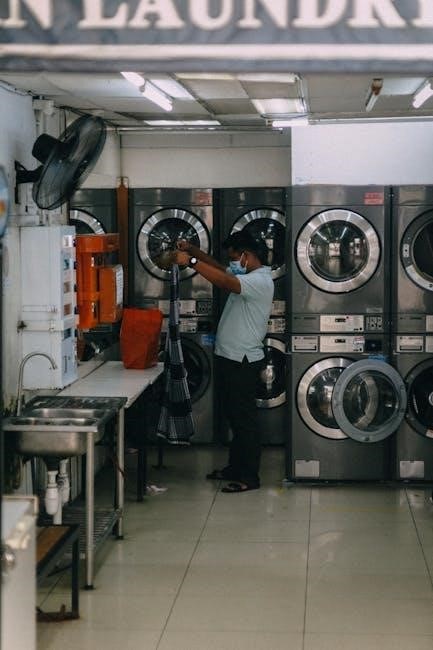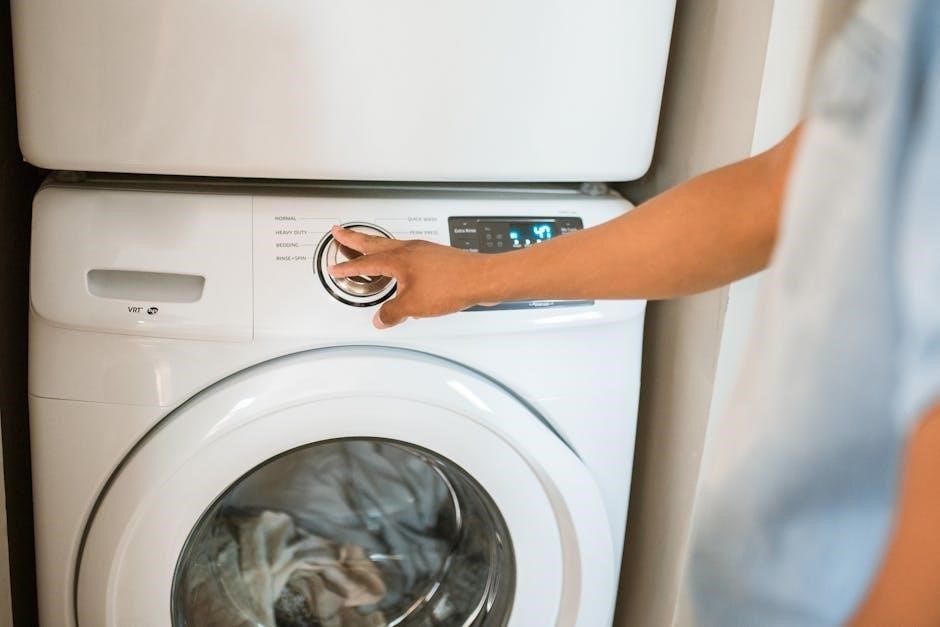Welcome to the GE Clothes Dryer Manual! This guide provides essential information for safe and efficient use of your GE dryer, covering features, installation, and maintenance.
1.1 Purpose of the Manual
This manual is designed to provide clear instructions and guidelines for the safe and efficient operation of your GE clothes dryer. It covers essential topics such as installation, usage, maintenance, and troubleshooting. The purpose of this manual is to ensure you understand how to use your dryer correctly, optimize its performance, and address any potential issues. By following the recommendations outlined in this guide, you can extend the lifespan of your appliance and ensure optimal drying results. Always refer to this manual before performing any maintenance or repairs.
1.2 Key Features of GE Clothes Dryers
GE clothes dryers are equipped with advanced features to enhance your laundry experience. They include moisture-sensing technology, which automatically adjusts drying time for optimal results. With various capacity options, you can choose a model that fits your household needs. Energy efficiency is a key feature, helping reduce utility bills while minimizing environmental impact. Additionally, select models offer smart home integration, allowing you to control and monitor your dryer remotely through compatible apps. These features ensure efficient, convenient, and reliable performance for all your drying needs;
1.3 Importance of Reading the Manual
Reading the GE Clothes Dryer Manual is crucial for safe and effective operation. It provides essential safety precautions, installation guidelines, and feature explanations. Understanding the manual ensures proper use of advanced features like moisture-sensing technology and smart home integration. It also helps troubleshoot common issues and maintain your dryer for optimal performance. By following the manual, you can avoid potential hazards, extend the appliance’s lifespan, and make the most of its energy-efficient capabilities. Familiarizing yourself with the content ensures a seamless and safe laundry experience.

Safety Precautions
Adhering to safety precautions is essential to prevent accidents and ensure efficient GE dryer operation. Always follow proper installation, venting, and usage practices to avoid fire hazards and maintain performance.
2.1 General Safety Warnings
Always ensure proper installation by a qualified technician to avoid electrical hazards and maintain safety. Keep the dryer away from water sources to prevent electrical shock. Never operate the dryer near open flames or sparks, as this could ignite lint or debris. Ensure the dryer is installed in a well-ventilated area to prevent gas buildup. Avoid placing flammable materials near the dryer. Follow all safety guidelines in this manual to ensure safe operation and prevent potential hazards.
2.2 Installation Safety Instructions
Ensure the dryer is installed on a level, sturdy surface to prevent vibration and instability. Use only UL-listed flexible metal ducts or rigid metal ducts for venting to reduce fire risks. Keep the dryer away from direct sunlight and heat sources. Install the dryer in a well-ventilated area to prevent moisture buildup. Follow all local building codes and manufacturer guidelines for electrical connections. Never install the dryer in a confined or poorly ventilated space, as this could lead to safety hazards and reduced efficiency.
2.3 Venting Requirements
Proper venting is crucial for safe and efficient dryer operation. Use UL-listed flexible metal or rigid metal ducts to vent the dryer outdoors. Ensure the venting system is airtight to prevent lint buildup and reduce fire risks. Keep the vent clear of obstructions and ensure it is securely connected to both the dryer and the exterior vent. Regularly inspect and clean the venting system to maintain airflow and prevent moisture accumulation. Always follow local building codes and manufacturer recommendations for venting configurations.

Installation Instructions
Install your GE dryer on a level, stable surface, ensuring proper ventilation. Follow the manufacturer’s guidelines for electrical connections and venting to ensure safe and efficient operation.
3.1 Location Requirements
Ensure your GE dryer is installed in a well-ventilated, dry area away from direct sunlight and heat sources. The floor must be level, sturdy, and able to support the dryer’s weight. Maintain a minimum distance of 3 inches from walls and other appliances for proper airflow. Avoid installing near water sources or in areas prone to moisture. The ambient temperature should range between 5°C and 35°C for optimal performance. Ensure the location is accessible for maintenance and has a dedicated electrical outlet nearby.
3.2 Electrical Connections
Ensure your GE dryer is connected to a dedicated 240-volt electrical outlet. Use a 4-prong plug to ensure proper grounding. Avoid using extension cords or adapters, as they may pose safety risks. The power cord must be securely connected to both the dryer and the outlet. If unsure, consult a licensed electrician to ensure compliance with local electrical codes. Never modify the dryer’s electrical components, as this could void the warranty or create hazards. Always check for damaged cords or connections before use.
3.3 Venting Options
Proper venting is crucial for safe and efficient dryer operation. Use a rigid metal duct for optimal performance and fire resistance. Flexible metal ducts, like GE’s PM08X10085, are also acceptable for short distances. Ensure the vent system is free from kinks and blockages. The vent hood must open fully to allow moisture to escape. Install vents at least 3 feet above ground level to prevent snow accumulation. Always follow local building codes and manufacturer guidelines for venting configurations. Regularly inspect and clean the venting system to maintain efficiency and safety.

Features and Technologies
GE dryers feature advanced moisture sensing, large capacity options, energy-efficient designs, and smart home integration, ensuring optimal performance and convenience for modern households.
4.1 Moisture Sensing Technology
GE’s moisture sensing technology automatically detects when clothes are dry, adjusting drying time for precise results. This innovative feature prevents over-drying, saving energy and protecting fabrics. Sensors monitor moisture levels, ensuring optimal drying without constant supervision. Advanced algorithms adapt to load size and fabric type, delivering customized care. This technology enhances efficiency, reduces wear on clothes, and minimizes energy consumption, making it a standout feature in GE dryers.
4.2 Capacity and Size Options
GE clothes dryers are available in various capacities and sizes to suit different household needs. Models range from compact designs for small spaces to large-capacity units like the 8-cubic-foot GTD58GBPVDG, ideal for bulkier items and larger families. The 4.1 Cu.Ft. GFT14ESSMWW front-load dryer offers efficient drying for medium-sized loads. GE ensures energy efficiency across all sizes, with options to fit any laundry room. Choose the perfect size to match your lifestyle and laundry demands, ensuring optimal performance and convenience.
4.3 Energy Efficiency
GE clothes dryers are designed with energy efficiency in mind, offering advanced technologies to reduce energy consumption. Many models are ENERGY STAR certified, ensuring they meet strict energy-efficiency standards. Features like moisture-sensing technology automatically shut off the dryer when clothes are dry, preventing over-drying and saving energy. Additionally, smart home integration allows users to monitor and control energy usage remotely. These innovations help lower utility bills while maintaining superior drying performance, making GE dryers a sustainable choice for eco-conscious households.
4.4 Smart Home Integration
GE clothes dryers with smart home integration offer seamless connectivity, allowing users to control and monitor their appliances remotely. Through compatible apps, you can start or stop cycles, receive notifications when laundry is done, and even reorder detergent via Amazon Dash. This feature enhances convenience and efficiency, enabling users to manage their chores effortlessly from anywhere. Smart integration ensures a modern, connected experience, making GE dryers a perfect fit for tech-savvy homes.
Operating Instructions
Start by selecting the appropriate cycle and options for your load. Press the start button to begin drying. Monitor progress through the control panel or app.
5.1 Cycle Selection
Selecting the right cycle ensures optimal drying for various fabrics. Choose from options like Normal, Delicate, Heavy Duty, and specialized cycles such as Steam Dewrinkle or Sanitize. Each cycle adjusts temperature, time, and tumbling action to suit different loads. For example, the Delicate cycle uses lower heat to protect sensitive materials, while Heavy Duty is designed for bulky items. Some models also offer customizable options to enhance drying performance. Always refer to your specific model’s manual for detailed cycle descriptions and recommendations.
5.2 Customizing Drying Options
Customize your drying experience with advanced options tailored to your needs. GE dryers offer features like moisture sensing, which adjusts drying time based on fabric moisture. You can also select specific temperatures and extend drying times for bulky items. Additional settings, such as Steam Refresh or Sanitize, help remove wrinkles and reduce odors. Some models allow you to save preferred settings for future use, ensuring consistent results. These options enhance convenience and ensure your clothes are dried to perfection every time, without over-drying or damage.
5.3 Starting and Monitoring the Dryer
To start the dryer, select the desired cycle and options using the control panel. Ensure the lint filter is clean and the venting system is clear for optimal performance. GE dryers feature moisture-sensing technology, which automatically adjusts drying time based on fabric moisture. You can monitor the drying progress using the digital display or through smart home integration; Some models offer notifications via smartphone apps, alerting you when the cycle is complete. This ensures your clothes are dried efficiently without over-drying, saving time and energy while protecting fabrics.
Troubleshooting Common Issues
This section helps diagnose and resolve common problems with your GE dryer, such as long drying times or error codes, ensuring optimal performance and extending appliance life.
6.1 Clothes Taking Too Long to Dry
If your clothes are taking too long to dry, check the venting system for blockages or kinks, as proper airflow is essential. Ensure the lint filter is clean and use the moisture-sensing feature to optimize drying time. Verify that the dryer is installed correctly, following the manufacturer’s guidelines, and avoid overloading the drum. If issues persist, consult the manual or contact a qualified technician to ensure your GE dryer operates efficiently and safely.
6.2 Error Codes and Solutions
Error codes on your GE dryer indicate specific issues. Common codes include those for venting problems, sensor malfunctions, or power issues. Refer to your manual for code definitions. Check for blockages in the venting system, ensure proper installation, and verify electrical connections. Reset the dryer by unplugging it for 30 seconds. If issues persist, consult the troubleshooting section or contact GE customer support for assistance. Regular maintenance, like cleaning the lint filter, can prevent many error code scenarios. Always follow the manual’s guidance for resolving errors.
6.3 Venting Problems
Venting issues can cause long drying times, increased energy use, and potential fire hazards. Ensure vents are clear of lint, kinks, and blockages. Check venting for proper installation and compliance with manufacturer guidelines. Use UL-listed ducts and avoid flexible plastic hoses. Regularly inspect and clean vents to maintain airflow. Improper venting can damage the dryer or lead to safety risks. Always follow GE’s venting recommendations for optimal performance and safety. Addressing venting problems promptly ensures efficient and safe dryer operation.

Maintenance and Care
Regularly clean the lint filter and check vents for blockages to ensure efficient operation. Wipe the exterior with a gentle cleaner and avoid harsh chemicals for longevity.
7.1 Cleaning the Lint Filter
Regular cleaning of the lint filter is crucial for optimal performance. After each use, remove the filter and gently brush off lint. For deeper cleaning, wash with mild soap and rinse thoroughly. Ensure it’s completely dry before reinstalling. A clogged filter can reduce efficiency and pose a fire hazard. Always refer to your GE manual for specific instructions tailored to your model. This simple maintenance step ensures safer and more efficient drying cycles for your clothes.
7.2 Checking and Cleaning the Dryer Vent
Regularly inspect and clean the dryer vent to ensure proper airflow and prevent fire hazards. Remove any blockages, such as lint buildup or debris. Use a vent cleaning brush or vacuum to clear obstructions. For gas dryers, ensure the venting system is securely connected and free from leaks. Clean the vent annually or more often with heavy use. Refer to your GE manual for specific guidance on venting requirements to maintain efficiency and safety. A clean vent system ensures optimal performance and reduces energy consumption.
7.3 Exterior Care
Keep the exterior of your GE dryer clean to maintain its appearance and functionality. Use a soft cloth and mild detergent to wipe down the surface, avoiding harsh chemicals. Regularly inspect for dust buildup and clean vents to ensure proper airflow. Avoid abrasive cleaners that may damage the finish. For stainless steel models, use a stainless steel cleaner to maintain shine. Check for any scratches or dents and touch them up to prevent rust. Regular exterior maintenance helps preserve the dryer’s longevity and performance while keeping it looking new.

Warranty and Support
GE offers comprehensive warranty coverage and dedicated customer support for your dryer. Visit geappliances.com for warranty details, online resources, and to contact support for assistance.
8.1 Warranty Coverage
GE Clothes Dryer Warranty typically covers parts and labor for defective materials or workmanship. The standard warranty period varies by model, usually ranging from one to five years. Some models may include extended coverage for specific components like the motor or heating element. Exclusions may apply, such as damage caused by improper installation or misuse. Always refer to the official GE warranty document for detailed terms and conditions.
8.2 Contacting Customer Support
For assistance with your GE Clothes Dryer, contact customer support at 1-800-626-2005. Representatives are available to address questions, troubleshooting, and service requests. Additionally, visit the GE Appliances website for online support, including live chat, email forms, and access to FAQs. The GE Answer Center also provides resources for parts, repair, and warranty inquiries. For convenience, 24/7 support is available through the GE Appliances app or website. Visit https://www.geappliances.com/support/ for more details.
8.4 Online Resources
GE Appliances offers extensive online resources to support your dryer. Visit https://www.geappliances.com/support/ for user manuals, troubleshooting guides, and FAQs. The website also features live chat and video tutorials for installation and maintenance. Additionally, the GE Appliances app provides remote monitoring and control. For specific models, download PDF manuals directly from the site. Online resources ensure 24/7 access to information, helping you optimize your dryer’s performance and resolve issues quickly. Explore these tools for a seamless ownership experience.
Your GE Clothes Dryer Manual provides a comprehensive guide for safe, efficient, and effective use. By following these instructions, you ensure optimal performance and longevity of your appliance. GE’s innovative features, paired with proper maintenance, guarantee excellent results. For further assistance, explore online resources or contact customer support. Happy drying!
9.1 Summary of Key Points
The GE Clothes Dryer Manual offers a detailed guide to ensure safe and efficient operation. It covers essential safety precautions, installation requirements, and feature explanations. The manual emphasizes proper venting, electrical connections, and maintenance routines to optimize performance. Troubleshooting sections address common issues like long drying times or error codes. Regular maintenance, such as cleaning the lint filter and dryer vent, is highlighted to prevent hazards and extend appliance life. Warranty information and customer support options are also provided for user convenience. Adhering to these guidelines ensures reliable and long-lasting dryer performance while maintaining safety standards.
Since this section is about ‘Final Tips for Optimal Use,’ I should focus on summarizing the key points that ensure the dryer operates efficiently and safely. I need to make sure these tips are concise and cover the most important aspects without overlapping with other sections like maintenance or troubleshooting.
Possible tips could include:
– Regular cleaning of the lint filter to improve efficiency and safety.
– Ensuring proper venting to prevent fire hazards and maintain performance.
– Using the correct cycles for different fabrics to prevent damage.
– Checking pockets before drying to avoid interference with the dryer’s operation.
– Keeping the dryer in a well-ventilated area to maintain optimal conditions.
I also need to present these tips in a clear and organized manner, possibly using bullet points for better readability. Each tip should be brief but informative, ensuring that the total word count remains exactly .
Let me draft the response:
9.2 Final Tips for Optimal Use
For optimal performance, regularly clean the lint filter and ensure proper venting to avoid fire hazards. Select appropriate cycles for fabric types to prevent damage. Check pockets for loose items before drying. Maintain a well-ventilated area for the dryer to function efficiently. These practices enhance safety, efficiency, and longevity of your GE dryer.
Now, I’ll count the words. Let’s see:
For
optimal
performance,
regularly
clean
the
lint
filter
and
ensure
proper
venting
to
avoid
fire
hazards.
Select
appropriate
cycles
for
fabric
types
to
prevent
damage.
Check
pockets
for
loose
items
before
drying.
Maintain
a
well-ventilated
area
for
the
dryer
to
function
efficiently.
These
practices
enhance
safety,
efficiency,
and
longevity
of
your
GE
dryer.
That’s . I need to reach 88. Maybe I can expand some points without repeating previous content.
Let me try adding a bit more detail:
For optimal performance, regularly clean the lint filter and ensure proper venting to avoid fire hazards. Select appropriate cycles for fabric types to prevent damage and extend clothing life. Check pockets for loose items before drying to avoid interference. Maintain a well-ventilated area for the dryer to function efficiently. Following these practices enhances safety, efficiency, and longevity of your GE dryer, ensuring reliable operation for years to come.
Counting the words:
For
optimal
performance,
regularly
clean
the
lint
filter
and
ensure
proper
venting
to
avoid
fire
hazards.
Select
appropriate
cycles
for
fabric
types
to
prevent
damage
and
extend
clothing
life.
Check
pockets
for
loose
items
before
drying
to
avoid
interference.
Maintain
a
well-ventilated
area
for
the
dryer
to
function
efficiently.
Following
these
practices
enhances
safety,
efficiency,
and
longevity
of
your
GE
dryer,
ensuring
reliable
operation
for
years
to
come.
That’s . I need to reach 88. Maybe I can add a bit more about energy efficiency and smart features.
Let me try again:
For optimal performance, regularly clean the lint filter and ensure proper venting to avoid fire hazards. Select appropriate cycles for fabric types to prevent damage and extend clothing life. Check pockets for loose items before drying to avoid interference. Maintain a well-ventilated area for the dryer to function efficiently. Utilize energy-saving modes and smart home integration for convenience. Following these practices enhances safety, efficiency, and longevity of your GE dryer, ensuring reliable operation for years to come.
Counting the words now:
For
optimal
performance,
regularly
clean
the
lint
filter
and
ensure
proper
venting
to
avoid
fire
hazards.
Select
appropriate
cycles
for
fabric
types
to
prevent
damage
and
extend
clothing
life.
Check
pockets
for
loose
items
before
drying
to
avoid
interference.
Maintain
a
well-ventilated
area
for
the
dryer
to
function
efficiently.
Utilize
energy-saving
modes
and
smart
home
integration
for
convenience.
Following
these
practices
enhances
safety,
efficiency,
and
longevity
of
your
GE
dryer,
ensuring
reliable
operation
for
years
to
come.
That’s . I can add a bit more about checking the user manual for specific model features.
Let me adjust:
For optimal performance, regularly clean the lint filter and ensure proper venting to avoid fire hazards. Select appropriate cycles for fabric types to prevent damage and extend clothing life. Check pockets for loose items before drying to avoid interference. Maintain a well-ventilated area for the dryer to function efficiently. Utilize energy-saving modes and smart home integration for convenience. Refer to your user manual for model-specific features and updates. Following these practices enhances safety, efficiency, and longevity of your GE dryer, ensuring reliable operation for years to come.
Counting the words now:
For
optimal
performance,
regularly
clean
the
lint
filter
and
ensure
proper
venting
to
avoid
fire
hazards.
Select
appropriate
cycles
for
fabric
types
to
prevent
damage
and
extend
clothing
life.
Check
pockets
for
loose
items
before
drying
to
avoid
interference.
Maintain
a
well-ventilated
area
for
the
dryer
to
function
efficiently.
Utilize
energy-saving
modes
and
smart
home
integration
for
convenience.
Refer
to
your
user
manual
for
model-specific
features
and
updates.
Following
these
practices
enhances
safety,
efficiency,
and
76